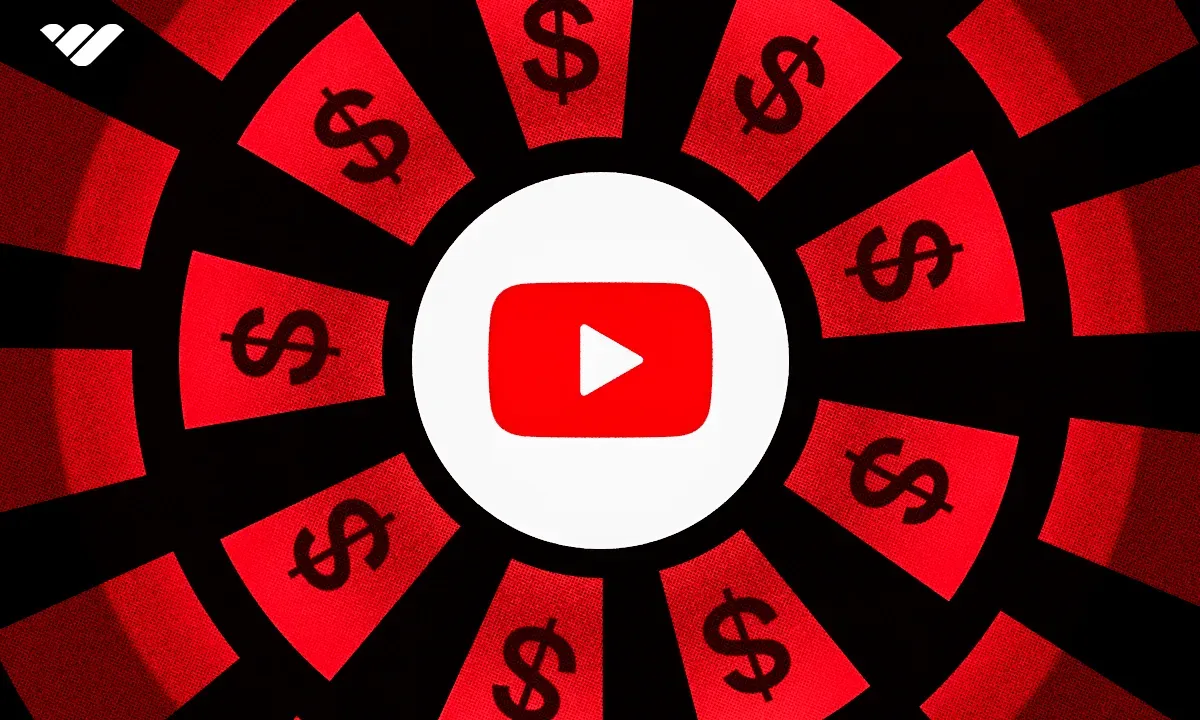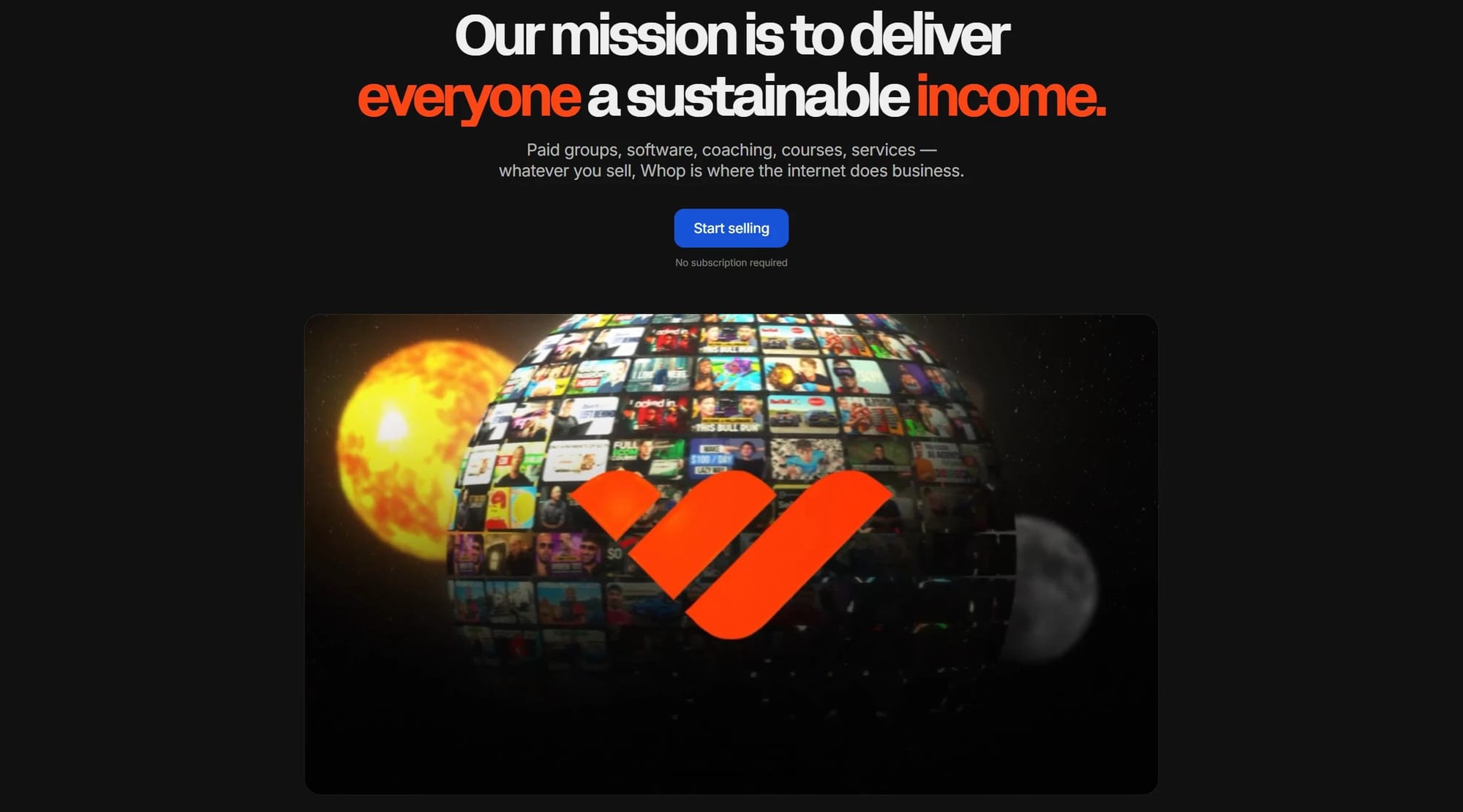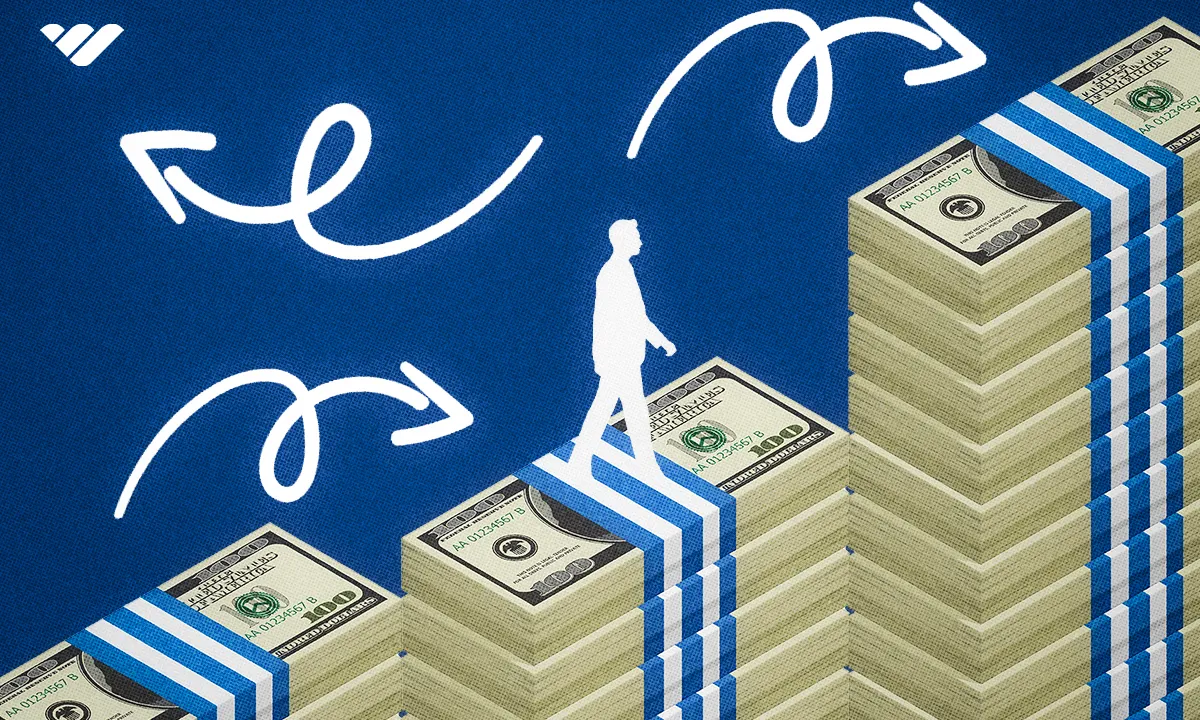Have 10k that you're looking to invest? Read this guide to find out how you can turn 10k into 100k, with both short and long-term strategies.
Key takeaways
- Starting with $10k, you can build wealth through low-barrier options like REITs, ecommerce, or digital products without needing massive capital.
- Digital businesses like blogs and online courses can generate passive, scalable income with minimal startup costs from your initial investment.
- Your risk tolerance and timeline should guide which wealth-building strategy you choose, from safer long-term investments to faster entrepreneurial ventures.
Creating and growing wealth feels like it should be easy, yet is anything but. There’s a lot of advice floating around on how to add another zero to your bank account, but a lot of it is dated and just doesn’t have any relevance today.
This post is going to give you a number of ways in which you can take your income up to 100k and beyond even if you have a little less than that 10k to your name, and they’re going to be things you can get started on right now.
So, You’re Looking for the Best Way to Invest 10k
If that big, bold statement just resonated with you, stop and take a moment. Adding a zero to your capital is all well and good, but it’s worth trying to figure out exactly what your financial goals are before going any further. Why exactly do you want to turn 10k into 100k? Is it the first milestone on the way to a million, or even ten mil? Or are you trying to pay off some debt, or saving up for a young (or future) child’s college fund?
Now that you’re sure about what your eventual goal is, you’ll want to look at the time frame. Sure, it’d be great to grow 10k into 100k within the course of the week–and it’s definitely possible–but a rate of return as high as that comes with a whole lot of risk. You could buy 10k worth of lottery tickets or take it to the nearest casino, but doing that sort of thing means you’re just as likely, or even likelier, to lose everything.
These risk and return considerations are going to dictate which of the methods of turning 10k into 100k that will best suit your own situation and appetite, and the longer you’re prepared to wait to hit that 100k mark, the safer you can go about it.
Now, let's get right to it: here are some proven ways to turn 10k into 100k.
14 Ways to Turn 10k Into 100k

1. Invest in Real Estate
Investing in real estate is one of the best ways to add another zero to your savings, but there’s a caveat here—you’re not going to be able to buy a whole property with 10k. Previous generations could and did, with the Baby Boomers taking advantage of affordable housing prices well into the 1970s and even ‘80s in some areas. Unfortunately, it’s a very different story today.
Nevertheless, you can still make 10k work in real estate in 2024 and beyond in a few different ways. The easiest option is REITs, or real estate invest trusts, which are companies that are listed on stock exchanges. When you buy a share of a REIT, you are essentially purchasing some of the real estate that the REIT owns, operates, or finances.
One of the biggest benefits of REIT investing is the fact that a big proportion of the property’s taxable income will be issued to you as a dividend, which you can then reinvest and grow your principal faster. Liquidity doesn’t hurt either, so if you see another 2008 coming, you can get out fast.
Another way to invest in real estate with a small lump sum is with fractional ownership. There are online platforms that offer this, so it’s generally just a matter of signing up and investing—and when you put your money in, you’re essentially supposed to have direct ownership over a portion of the property. Some firms will even represent this ownership via blockchain-based tokens.
It’s also possible to get into real estate crowdfunding and syndication, but they tend to be far less liquid versions of the same fractional ownership model. That said, crowdfunding as well as fractional ownership do allow you to diversify risk by spreading your capital across multiple properties, unlike syndication.
If you want to find out more about real estate investing as well as all the tips and tricks from experts and other experienced heads, check out Whop’s real estate groups and communities right here!
2. Start an Ecommerce Business
Ecommerce is another fantastic way of multiplying your capital, and you’ll be able to do so pretty quickly if you can learn the ropes and nail down a good business plan. Starting your own ecommerce business is not without risk, but it’s an extremely rewarding and highly sustainable way of making money online.
The advantage of having 10k in the bank to invest in a business is that it can take care of all of your starting costs and fund your initial batches of inventory. Many ecom business owners need to go into debt just to buy that first batch, but you’re probably not going to have that problem with 10k ready to go.
Dropshipping is one of the most common forms of ecommerce, and you’ve probably bought items online that have been dropshipped—essentially, you’re operating the store and handling marketing, but you never see the inventory as orders are routed straight to the supplier, who handles fulfillment.
Then there’s print-on-demand (POD) which is essentially the same thing, with the added step where you’ll create the images or text to be printed on the goods. All those influencers selling generic hoodies and coffee cups with their branding or slogans? Yup, that’s POD, and you can do it too.
The best thing about ecommerce is that you can also just pick a business model that eschews inventory and physical products altogether, focusing instead on digital products. So, whatever you think there’s a gap in the market for, ecommerce can help you fill it, raking in all the dough you want in the meantime. Here’s some inspiration for ecommerce business ideas that you can get started on right away.
3. Start a Blog

If you have enough time on your horizon as well as your hands to put the work in, a blog can be an excellent way of reaching and even exceeding those financial goals. In fact, once you have an established blog to play with, it can be hard to stop, and will bring in income passively for you since you can invest some of its revenue to keep the wheels turning.
You won’t need to dip too deep into your 10k nest egg to get a blog started, either. A couple of hundred bucks will set you up with decent hosting, which leaves plenty left over. You’ll then need to decide if you want to do the writing yourself, or hire that out—it’s very possible to find writers online at rates of around $0.10 per word.
Given that blogs tend not to make very much money at all until they’re relatively established, you might want to do a bulk of the work to start with and hire out occasional pieces before reversing that as you start to see money come in. When starting out, you should try and get as much out of affiliate marketing when you can, but once you’ve made your presence felt you’ll start to get plenty of advertising and requests for sponsored posts.
Beyond affiliates, having a couple of other digital products always helps—you can cross-pollinate revenue streams very effectively by, for instance, having your blog point to any courses you sell. Your courses then refer to your eBooks, and soon you’ll have cash coming in from all of these sources, helping you to hit six figures even faster.
Done right though, a blog on its own can pull in recurring revenue with surprising consistency, and it’ll do so passively for you if you reinvest some of its income into writers, editors and marketers who can keep it going—and growing. If you want to give blogging a try, here’s some further reading.
4. Create and Sell Online Courses
Online courses and internet-based education in general is an industry that’s booming but also not expected to slow down anytime soon, and it’s a market projected by Statista to clear 1.1 billion users in 2029.
That should come as no surprise either, given that businesses are increasingly turning to online course providers to help their employees develop—and on the other side of the coin, more and more people are changing careers and starting new businesses thanks to the skills learned through online courses.
If this sounds like a great market to get into, then you’d be right. Selling online courses is a fantastic way to make money, and like some of the other content creation options on this list, it requires very little capital to get started. All you really need to start making online courses is some skill and knowledge of your own, and the ability to communicate that to anyone who wants to learn.
If course creation sounds like a good idea but you’re not quite sure what to teach, it’s worth doing a little research into what sort of niches are in demand at the moment. The AI ship has probably sailed at this point, but in 2022 and 2023, creators making good courses on leveraging AI were really raking in the dough. Getting into an in-demand niche fast, even if that means informing yourself rapidly and putting out course materials with what you’ve learned, can really make the difference.
The other thing that’ll help you make money selling courses is to choose the right platform to create and sell your course on. There are several different types of course platform, and different revenue models to think about.
Skillshare and Udemy, for instance, operate as marketplaces—which means that, since they’re sending students to you, you’ll not earn a big proportion of the revenue your course brings in. On the other extreme, Kajabi is a platform that helps you get set up and sell, but charges a steep flat fee that’ll eat away at your 10k in no time.
Choosing a platform like Whop can make all the difference when it comes to selling online courses—you’ve got the discoverability of platforms like Udemy but retain more revenue, and you don’t have to pay a cent in fees.
Your whop hub includes a full-featured course builder that’s right on par with the best in the industry, and you can sell any other kind of digital product right next to your courses, letting you monetize in multiple ways with complementary offerings. It only takes a few minutes to get set up on Whop, and you can give it a try for free.
5. Try Growth Marketing
Growth marketing is a data-driven marketing approach that helps businesses to grow fast, and you could turn your skills and grasp of either data or social media to it either to grow your own business or help other firms as a consultant.
As an industry, growth marketing is becoming more and more ubiquitous, so you’ll have to face your share of competition if you want to become a growth marketer. However, the upside is significant and not everyone can do it, meaning that it’s easy to establish yourself and build a reputation if you approach things right.
Growth marketers operate using their own initiative, and they’re prized by small businesses because they can provide a different perspective as well as the agility to hit the ground running as soon as they sign up. This is where you can make a difference, stepping into the breach and generating results fast.
In terms of what sort of skills you’ll need to pull off a gig as a growth marketer, the main thing will be the ability to analyze data and then utilize those findings to design social media campaigns. And not just any sort of social media—we’re talking the stuff that really works for today’s younger generations of consumers, such as leveraging UGC and micro-influencers.
The good thing is that it won’t take much capital to start off as a growth marketer—you’ll need to establish a web presence for yourself, of course, and it could pay to brush up on your knowledge by finding an expert or two to learn from. How? Check out Whop’s social media groups and give them a scan to find the perfect match.
6. Invest in the Stock Market

Investing in the stock market is probably the most old-school way of turning 10k into 100k, but it’s one of the best for several reasons. Foremost among these perhaps is the fact that you can do so in different ways, and there’ll generally be a method that matches your time horizon and appetite for risk.
It’s important to note here that stocks as a whole are traditionally considered a relatively high-risk asset class, but even that view might be changing as ‘safer’ assets like bonds disappear from the consciousness of the humble retail investor.
The simplest form of stock market investing is to sink your money into an index fund. This means the S&P500 a majority of the time, so what it boils down to is betting that the top 500 US-listed companies will continue to do well over a longer horizon. Nobel Prize-winning economist Robert Schiller proved that this is generally a winning strategy, with an annualized return of over 7%. That gets even better if you’re able to reinvest your dividends, thereby compounding your investment, earning over 10%.
At 10%, your money will double every seven years or so. That means it’ll take quite a while to get to 100k, but importantly, an index fund investment is pretty low-risk in the grand scheme of things. It’s also quite liquid, and requires almost no work on your behalf beyond getting set up with a trading account.
On the other end of the stock market spectrum, there are several high-risk, high-reward trading strategies that you can look into. 10k to 100k in days is not just possible but realistic using instruments like options, and the more capital you have, the more you can leverage it to increase your profit potential.
However, trading with derivatives like options and getting into trading styles like day trading and scalping can be very risky—options especially are just like gambling given that you’re playing against the house, and the house not only knows what bets you’re placing (via practices like Payment for Order Flow) but also straight up dictates stock prices, often causing retail traders like you to lose out.
That’s not even a joke. Citadel Founder and CEO Ken Griffin recently said, and this is verbatim, “Markets are efficient because of active managers setting the prices of securities.” Citadel, by the way, is both an active manager (read: hedge fund) and a market maker, although the two arms are supposed to run independently.
So, how can you succeed in such shark infested waters, especially if you don’t consider yourself much more than an intermediate or even beginner when it comes to stocks? Check out Whop’s trading page. There are plenty of trading groups and coaches there who can help you level up your skills, and gain enough knowledge to feel comfortable with both the safer styles of stock investing as well as high-risk assets like options.
7. Invest in Crypto
Speaking of high-risk assets, you can also look into cryptocurrencies. Much of the risk factor in crypto comes from the fact that it’s extremely new ground, and the underlying tech can be pretty tough to understand if you don’t have a computer science background. Crypto also tends to take quite a beating in mainstream media, and in some cases it’s definitely a fair cop—there are lots of scams out there in crypto, and some of the most high-profile projects (think monkey JPEGs) have fizzled out dramatically.
That being said, crypto has offered incredible potential for wealth accumulation over the years. Imagine buying a couple of Bitcoins for $5 a pop back in 2012, or even for one grand in 2017. You’d have turned 2k into 100k in the latter example, and gone from $10 bucks to $100,000+ in the former.
The “blue chip” cryptocurrencies like BTC and Ethereum have been around for a long time and are considered relatively safe within the asset class, but the inherent volatility of crypto can swing even these—you’d be panicking if you woke up to your stock portfolio dipping 10% overnight, but those are rookie numbers for a crypto veteran.
The greatest earning potential in crypto is generally to be had in altcoins, or smaller cryptocurrencies. The principle is simple—if you spot a worthwhile project early on, and grab a bunch of coins or tokens while they’re still cheap, there’s the potential for their value to go ballistic once the wider crypto public and especially institutional players find out about it.
Here’s the problem, though. First of all, it’s not too easy to find a good project and get in early—anyone can create a token easily, and lots of people are making a bunch of new currencies on a daily basis. Since crypto went mainstream, it’s really hard to pinpoint what that next big thing is going to be given the amount of white noise as well as outright scam currencies out there.
Second, most legit projects need some seed capital even if it’s to pay the founding team’s bills for a few months. A lot of crypto projects, as a result, are doing private funding rounds… so even if you think you’re getting in early when a hot project does an exchange listing, the truth is that you’re probably providing exit liquidity for a hedge fund.
Crypto does have a lot of advantages, with the transparency and immutability of the blockchain giving you a trading environment where the math tends to work out—if you trade on-chain, you don’t need to worry about things like naked shorting inflating the coin supply beyond what it’s supposed to be, as happens on the stock market. What you see is generally what you get.
So, to make crypto investing work, you either need to have an eye for good projects and knowledge of the blockchain industry, or an ear to the ground and a way to spot new projects. It’s hard to go either route alone, so give yourself the best possible chance of success with crypto by joining one of Whop’s crypto communities. You’ll find plenty of courses and crypto education there, as well as people like you on the hunt for the next big thing in crypto.
8. Write and Sell Ebooks
If you’ve got experience in a certain area, a collection of anecdotes, or just a message to send the world, writing a book feels like the most natural way to go. The problem is, traditional publishing can be a long and arduous process, and if you choose to self-publish, 10k might actually not be enough to get all of the printing done and transport copies onto shelves.
Ebooks take care of all of that, in addition to being super accessible given that they can be downloaded and viewed on any device by anyone in any corner of the world. As long as you’ve got your payment processing sorted, your eBooks can be a borderless revenue stream for you—and you won’t need to dive too far into that 10k stack of yours to get things goings given that there’s not much investment required.
All you’ll need to spend on, really, is getting your cover art right. Just like with physical books, this is important—the right colors, fonts, text and graphical elements need to work together and appeal to the reader, letting them know what your eBook’s all about and why they should buy it.
In fact, ten thousand dollars is just about right if you want to outsource the entirety of your eBook. We’ve already mentioned the sort of rates you might expect to hire a writer for online, and after paying for the cover art, you’ll still have 9k+ to throw at a writer to get the entirety of your eBook written. Given that only the longest eBooks stretch to 100,000 words, and many are in the 20k-30k word range, you might even be able to get a small trilogy done.
Once your eBook is written and your cover art is designed, all that remains is to publish and sell it on an online platform. Just like with courses, we’d recommend that you take a look at Whop if you want to sell eBooks—you can do so easily using the eBooks app on your hub, and unlike other platforms, Whop doesn’t eat into your sales revenue given that the platform fee is just 2.7% + $0.30.
9. Create a Paid Community

Community is one of the pillars of human society, so it should come as no surprise that it’s equally as important to the world of commerce or, in this case, ecommerce. Online communities can be a huge opportunity for revenue if done right, so a paid community can play a big role in getting you to that 100k mark.
There are generally two ways to build an online community: create a group revolving around a certain theme, such as a cause, an interest, a hobby or something similar; or set up a community around another venture of yours, whether that’s a business or the content you create.
You might be familiar with the latter. Almost every influencer, for example, has an online community. It’s the fan club of the modern age, and importantly, a chance for consumers to contribute monetary support towards the creators of content that they, in many cases, enjoy far more than anything mass-produced or commercial. Think about it—do you spend more time on YouTube/TikTok or in front of the TV?
If you use some of the other methods that we’ve outlined in this list or create some alternate form of content, a paid community is the perfect complement and a way to allow your core audience to become contributors. Whether it’s a podcast, a course, a YouTube or TikTok, an eBook or anything else, getting your audience together in once place is a great move—aside from membership subs or donations, it also makes for a great source of feedback, and a market for any other future products you may create.
In that spirit of bringing all of your digital products together, Whop is a great place to create and monetize a community. You can do this via your whop hub by adding the community-related apps you want, or do it on your own site or a platform like Discord using Whop integration.
10. Launch a Paid Newsletter
Newsletters are extremely valuable marketing tools, but they can be excellent money-makers in their own right. Nine out of ten Americans are subscribed to at least one email list, and that means advertisers are very aware of the reach that newsletters can provide.
You’ll need to start getting your newsletter into a significant number of inboxes before advertisers start signing on, but there’s ways to start the ball rolling even with issue number one. Donations, for instance, are something you can request straight away, and readers who really appreciate your content aren’t likely to be too stingy with their tips.
Affiliate marketing is another tactic you can easily incorporate into your newsletter, and it’s a very fair way of doing things—if it’s your newsletter or content that introduces a reader to a product or convinces them to make a purchase, why shouldn’t you earn a commission?
All of that said, we haven’t even gotten into the specifics of an actual paid newsletter yet—everything we’ve mentioned thus far works fine in a free email. Asking people to pay for your newsletter can be a tricky business, so make sure you’re underlining the benefits, such as market intel, deals, or other content that they just won’t get anywhere else.
You might only be able to launch your premium newsletter once you’ve built up a big enough audience, so it’s hard to tell just how long it’ll take to start scaling this revenue stream—but it certainly doesn’t require much investment. And if you can offer enough value to a big enough pool of people, you can hit that 100k goal in record time.
If you want to learn about all the ways that newspapers make money, take a look at this in-depth guide.
11. Flip for Profit with Retail Arbitrage
Retail arbitrage is simple in concept but can be tricky to execute—and like many difficult forms of business, it can be very profitable. If you haven’t heard of it before, retail arbitrage means buying consumer goods on a public marketplace and selling it on another, taking advantage of any possible discrepancies in price or supply and demand.
To use two of the biggest public marketplaces as an example, this could mean buying items on clearance from a seller like Walmart, then offering them out individually on eBay, where getting set up as a seller is a little easier than on marketplaces like Amazon or the aforementioned Walmart.
Facebook Marketplace is another commonly used platform in retail arbitrage given that there’s much less competition for certain rare items, especially when bought local, and you can do plenty of haggling to up your profit margins even further.
Clearance, wholesalers, return pallets and even liquidation events are all great sources of good you can pick up and sell for a profit, but this is a business model that takes work—you’ve got to be switched on, have a nose for good deals, and think about how to deal with inventory.
If you want to get good at flipping, a reselling community may be for you. Hop into one of Whop’s groups and find out how the experts approach retail arbitrage, get alerts to deals and price errors, and even grab bots to automate your reselling business.
12. Start a YouTube Channel

YouTube is a fantastic source of income for all sorts of creators, and depending on the niche, can be extremely profitable. If you create content that’s targeted towards high-spending demographics (such as finance content for the US market) you could earn a significant amount of money from a small YouTube channel via platform ads alone.
The secret to YouTube is to just keep creating, and if you’re able to provide a certain level of consistency in your content, you’ll start to attract an audience wanting more of the same. From that point on it’s about learning about and managing the algorithm—your core viewers will keep coming back, but you might have to play with your thumbnails and titling in order to get seen by new people.
One of the big advantages about content creation is that it doesn’t cost much to get started, and it’s entirely possible to start earning money on YouTube for free. It’s a dead cert that you’ve already got a mobile phone and maybe even a computer, and the former can handle all of your video and audio. You can even find decent editing software for your phone!
Speaking of editing, DaVinci Resolve is probably the best editing software out there for PC, and it’s totally free. It’ll take a bit to learn and get comfortable with, but once you’re up and running, you can do just about anything.
To make proper, studio-quality content, you might need to invest a little bit—a good microphone can make all the difference, and a high-quality camera and some lighting gear can help too. Still, we’re only talking a few hundred bucks, nowhere near that 10k that you’re looking to multiply.
Actually making your YouTube channel a 100k business may take some time, because it’ll take a while to get established, learn the tricks of the trade, and get comfortable with your own style of content. When all of those building blocks are in place, though, you should see ad revenue coming in and growing with each video you publish—and you can sell merch, complementary digital products, and monetize your core audience with a paid community to really ramp up your YouTube earnings.
13. Sell PLR Digital Products
Private Label Rights digital products are a fantastic business model that you can put to work quickly, and 10k can become 100k very quickly if you get the formula right.
If you haven’t heard of it before, PLR products are mostly developed products that you can apply the finishing touches to and sell under your own brand or label. This means that you don’t have to spend the time and resources required for product development and testing, and you can put out products that you may not even have the skill to create.
When it comes to PLR digital products, this could be software, graphics, videos, and even entire courses or eBooks that you can customize and distribute electronically under your own brand—this obviously means that the onus is on you to sort out the marketing and get the products out to your audience.
The 10k you already have is a perfect amount of starting capital to set up your brand and pay for your first PLR digital products, which you can then turn around and sell. Customizing them is half the battle, but the rest of it is to find a platform that’s got plenty of reach with marketplace visitors as well as being willing to give you the freedom to sell just about any digital product.
Whop checks both boxes, gives you lots of marketing options, and helps you bundle different PLR digital products together in order to upsell. All that’s left, then, is to invest in the highest-quality PLR digital products out there and get started right away.
14. Invest in a Small Business
Finally, investing in an existing business is another great way to make your money grow, although there are several risks to this. First of all, you need to decide how deep you want to go—an established business can cost a fair bit, especially a profitable one, so you might have to put all of your eggs in one basket. Then there’s liquidity, because once you’re in, you’re not going to be able to sell out overnight. Your money’s locked in, for a while at least.
You can also go in with a minority stake in a small business, and that might mean fewer headaches since you won’t have to worry too much about operations. The question of your relationship with the other business owners then comes into question, though, and roles and boundaries need to be very clearly defined right from the outset. Liquidity’s also going to remain an issue.
Just like we mentioned in the crypto section, though, getting into an investment early can be everything. Just think about Ronald Wayne, the third co-founder of Apple—he was only on the company’s books for 12 days, having been written in on day 1. He sold his 10% stake in the company to Steve Wozniak for, wait for it… $800. Yes, that’s 10% of Apple, for $800.
You may not necessarily be buying into a future megacorp on day 1 or 12 when you invest in a small business, but that’s an extreme example. Countless investors have made millions doing this, and it’s the entire business model of Venture Capitalists.
The trick is actually finding early-stage businesses to invest in. Your network might be the best place for that, but today, network doesn’t just mean family and friends—if you’re part of one of these Whop communities, you’re going to be hanging out with lots of other entrepreneurial folks.
What’s the Best Way to Make 100k From 10k?
We’ve just given you 14 ways to make 100k from 10k, but the best way is going to be up to you, your preferences, and your skillset—if you’ve got an intuitive handle on business and enjoy its challenges, you might go in for flipping or buying out a small business, but if you just want to invest your money and let it work, investing in stocks or crypto may be the way to go.
Ultimately though, the best way to make 100k is the one that provides maximum reward with the minimum risk, meaning lowest investment, and by reading through our list it might be apparent that digital products offer that sort of low investment, high income balance. Unless you’re outsourcing, all they require is your own creativity, skill, and effort, and they can be sold to infinite scale if marketed right.
By selling digital products, you can also combine revenue streams to multiply your earning potential—but importantly, the products aren’t incongruous. There’s every opportunity for you to create complementary groups of digital products that just make sense to your audience, maximizing customer value.
Consider, for example, starting with online courses. It’s a no-brainer of a digital product to create given the market for it, but should you stop there? Absolutely not. Write an eBook, and you’ll see students who want more knowledge from you picking it up. Start a community, and keep the knowledge flowing. Publish a newsletter, and keep past students and current community members on the hook.
That’s four digital products, all working together, ramping up the marketing, bringing in different forms and streams of revenue.
Start Your Journey to 100k With Whop

If the above sounds far too good to be true, stop right there. More and more creators are doing exactly that sort of thing and more, powered by platforms like Whop that make execution an absolute breeze.
When you get on Whop, your whop hub lets you manage a variety of different options by bringing in the relevant apps. To publish and sell courses, just drag the Whop Courses app in, and you’ve got yourself a course builder. Products like software and eBooks can be uploaded and offered on your store page with a single click, and Whop puts no restrictions on the type of software you can sell.
All you need to do to get started on your journey to 100k is to visit Whop and create an account, or talk to the team about how Whop can help you build your new online business out exactly how you want it.



